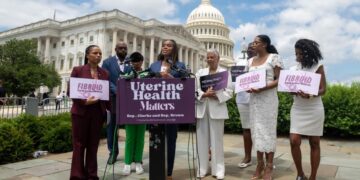Feb 20, 2025 Story by: Editor
Health insurance coverage plays a crucial role in ensuring access to healthcare and protecting families from excessive medical expenses. However, longstanding racial and ethnic disparities in health coverage contribute to broader health inequities. This report examines trends in health coverage by race and ethnicity from 2010 to 2023 and explores the potential implications for health disparities. The analysis is based on data from the American Community Survey (ACS) conducted by KFF, covering individuals under the age of 65. All noted differences between groups and years are statistically significant at the p<0.05 level.
Key findings include:
Between 2019 and 2023, most racial and ethnic groups experienced an increase in health coverage following a period of rising uninsured rates during the first Trump administration. The primary driver of these coverage gains was Medicaid expansion, reflecting policies implemented during the COVID-19 pandemic to stabilize and increase access to affordable healthcare. These policies included enhanced subsidies for purchasing Marketplace coverage and a mandate requiring states to maintain continuous Medicaid enrollment during the public health emergency (PHE).
As a result, Medicaid enrollment reached record levels. Although Medicaid enrollment declined after pandemic-era protections were lifted, it remained higher than in 2019. These coverage gains helped reduce disparities in uninsured rates for Hispanic, Black, and American Indian or Alaska Native (AIAN) individuals compared to White individuals. However, these gains are at risk due to potential Medicaid cuts and the expiration of enhanced Marketplace subsidies.
Despite these improvements, disparities in health coverage persisted in 2023. AIAN and Hispanic individuals under 65 had the highest uninsured rates at 18.7% and 17.9%, respectively. Uninsured rates were also higher for Native Hawaiian or Pacific Islander (NHPI) individuals (12.8%) and Black individuals (9.7%) compared to White individuals (6.5%).
These disparities have persisted over time and, in some cases, have worsened. For instance, between 2010 and 2023, the uninsured rate for AIAN individuals increased from 2.4 to 2.9 times the rate for White individuals, while the Hispanic uninsured rate increased from 2.5 to 2.7 times the White rate. Additionally, Black individuals remained 1.5 times more likely to be uninsured than White individuals.
Uninsured rates remained higher in states that had not expanded Medicaid compared to expansion states across most racial and ethnic groups as of 2023.
Furthermore, disparities in coverage between Hispanic, Black, and NHPI individuals compared to White individuals were more pronounced in non-expansion states. However, the relative risk of being uninsured for Black and Hispanic individuals compared to White individuals was similar in both expansion and non-expansion states.
Looking ahead, racial and ethnic disparities in health coverage may widen due to potential Medicaid reductions, the expiration of enhanced Marketplace subsidies, and changes in immigration policy. The incoming Trump administration and a Republican-controlled Congress are signaling plans for significant changes to Medicaid and the Affordable Care Act (ACA).
House Republicans are reportedly considering substantial Medicaid cuts to offset the cost of extending expiring tax cuts. Such cuts would likely shift financial responsibility to states, leading to reductions in Medicaid eligibility and benefits. Additionally, if Congress does not extend the enhanced ACA Marketplace subsidies set to expire in 2025, rising premiums may result in an increase in uninsured individuals. Furthermore, potential changes in immigration policy, including increased enforcement, the removal of protections in sensitive locations such as healthcare facilities, and revisions to public charge policy, could decrease health coverage enrollment among lawfully present immigrants and citizen children in immigrant families.
These potential losses in Medicaid and Marketplace coverage would likely exacerbate racial disparities in coverage, as Hispanic, Black, AIAN, and NHPI individuals disproportionately rely on these programs. In turn, this could contribute to widening disparities in overall health outcomes.
Trends in Uninsured Rates by Race and Ethnicity, 2010-2023
Prior to the implementation of the ACA in 2010, Hispanic, Black, Asian, AIAN, and NHPI individuals under 65 were more likely to be uninsured than their White counterparts, with Hispanic and AIAN individuals facing the highest risk of lacking coverage. The primary reason for these higher uninsured rates was limited access to affordable health insurance options.
Although most individuals across racial and ethnic groups have at least one full-time worker in their family, disparities in employment and income contribute to reduced access to employer-sponsored health insurance or challenges in affording private coverage. Medicaid provided a safety net for some, but before the ACA, Medicaid eligibility for parents was highly restrictive in most states, often limited to those earning below 50% of the poverty level. Additionally, childless adults were generally ineligible under federal rules.
Between 2010 and 2016, the ACA led to significant coverage expansions across all racial and ethnic groups, but disparities persisted. The ACA introduced coverage options for low- and moderate-income individuals, including dependent coverage extensions, prohibiting insurers from denying coverage or charging higher premiums based on health status, and expanding Medicaid in participating states.
These changes resulted in substantial coverage gains, particularly after Medicaid and Marketplace expansions in 2014. Hispanic individuals under 65 saw the largest improvement, with their uninsured rate declining from 32.6% to 19.1%. Black, Asian, and AIAN individuals also experienced larger coverage gains compared to White individuals. However, despite these improvements, Hispanic, Black, AIAN, and NHPI individuals remained more likely to be uninsured than White individuals in 2016.
From 2017 to 2019, coverage gains reversed, and uninsured rates increased for three consecutive years. The uninsured rate among individuals under 65 rose from 10.0% in 2016 to 10.9% in 2019. Hispanic individuals saw the most significant increase, with their uninsured rate rising from 19.1% to 20.0%.
Uninsured rates also increased for white individuals (from 7.1% to 7.8%) and Black individuals (from 10.7% to 11.4%). AIAN, NHPI, and Asian individuals did not see significant changes in their uninsured rates during this period. These coverage losses were likely influenced by policy shifts under the first Trump administration, including funding cuts for outreach and enrollment assistance, state waivers imposing new Medicaid eligibility requirements, increased eligibility verification measures, and public charge policy changes that deterred some immigrant families from enrolling in Medicaid and the Children’s Health Insurance Program (CHIP). Many of these policies were later reversed by the Biden administration.
Between 2019 and 2023, uninsured rates declined again, following several years of increases before the pandemic. The number of insured individuals under 65 rose by 3.6 million during this period, reducing the uninsured rate from 10.9% to 9.6%. (Data from 2020 was excluded due to COVID-19-related disruptions in data collection.) AIAN individuals experienced the largest improvement, with their uninsured rate decreasing from 21.7% in 2019 to 18.7% in 2023. Uninsured rates also declined for Hispanic individuals (from 20.0% to 17.9%), Black individuals (from 11.4% to 9.7%), Asian individuals (from 7.2% to 5.8%), and White individuals (from 7.8% to 6.5%).
Eligibility for ACA Coverage Among Uninsured Individuals Under Age 65 by Race and Ethnicity (2023)
Uninsured Black individuals under 65 are more likely than their White counterparts to be caught in the Medicaid “coverage gap” due to a larger proportion living in states that have yet to implement Medicaid expansion under the Affordable Care Act (ACA). As of November 2024, ten states have not adopted the Medicaid expansion, with most located in the South, where a significant portion of the Black population resides. In these states, approximately 1.5 million uninsured individuals with incomes below the poverty level fall into the “coverage gap,” making them ineligible for both Medicaid and ACA Marketplace subsidies.
Medicaid Expansion and Racial Disparities
Data from KFF reveals that states with higher Black populations tend to have lower Medicaid expansion adoption rates. As shown in Figure 5, some states with over 15% Black populations still have not expanded Medicaid, exacerbating disparities in healthcare access.
Additionally, uninsured Asian, Black, Hispanic, and Native Hawaiian or Pacific Islander (NHPI) individuals under 65 are less likely than White individuals to qualify for coverage due to a larger proportion being noncitizens. Many lawfully present immigrants must wait five years after obtaining legal status before becoming eligible for Medicaid. Meanwhile, undocumented immigrants are entirely barred from Medicaid and cannot purchase coverage through the ACA Marketplaces (Figure 6).
The Impact of COVID-19 on Health Coverage
Policies introduced during the COVID-19 pandemic helped stabilize insurance coverage and contributed to gains, primarily through increased Medicaid enrollment. Temporary continuous enrollment provisions during the Public Health Emergency (PHE) played a key role in expanding Medicaid coverage. Furthermore, enhanced Marketplace subsidies under the American Rescue Plan Act (ARPA), extended through 2025 via the Inflation Reduction Act (IRA), facilitated greater access to affordable health insurance.
Despite these gains, disparities persisted. Following the conclusion of the Medicaid continuous enrollment provision in March 2023, millions of individuals lost coverage. While racial and ethnic data on disenrollments remain limited, studies suggest that Black and Hispanic individuals were twice as likely as White individuals to lose Medicaid due to difficulties completing the renewal process. Many disenrolled individuals struggled with communication barriers with their Medicaid agencies, leading to gaps in coverage, increased out-of-pocket expenses, and reduced access to healthcare services.
Future Challenges and Potential Policy Changes
Looking ahead, racial and ethnic disparities in healthcare coverage could widen due to potential Medicaid cuts, the expiration of enhanced Marketplace subsidies, and changes in immigration policies. The incoming Trump administration, alongside a Republican-controlled Congress, has indicated plans to overhaul Medicaid and the ACA. House Republicans are reportedly considering substantial Medicaid funding reductions, shifting costs from the federal government to states, which may lead to stricter eligibility criteria and reduced benefits.
Moreover, if Congress does not extend the enhanced ACA Marketplace subsidies set to expire in 2025, insurance premiums are expected to rise, likely increasing the number of uninsured individuals. Additionally, potential immigration policy changes, such as increased enforcement, the rollback of protections at healthcare facilities, and alterations to public charge rules, could reduce enrollment among lawfully present immigrants and citizen children in immigrant families.
Ultimately, Medicaid and Marketplace coverage losses would likely exacerbate racial disparities in healthcare access, particularly affecting Hispanic, Black, American Indian/Alaska Native (AIAN), and NHPI populations who disproportionately rely on these programs. Without policy interventions, these disparities could contribute to broader inequities in health outcomes across racial and ethnic groups.
Source: KFF
















